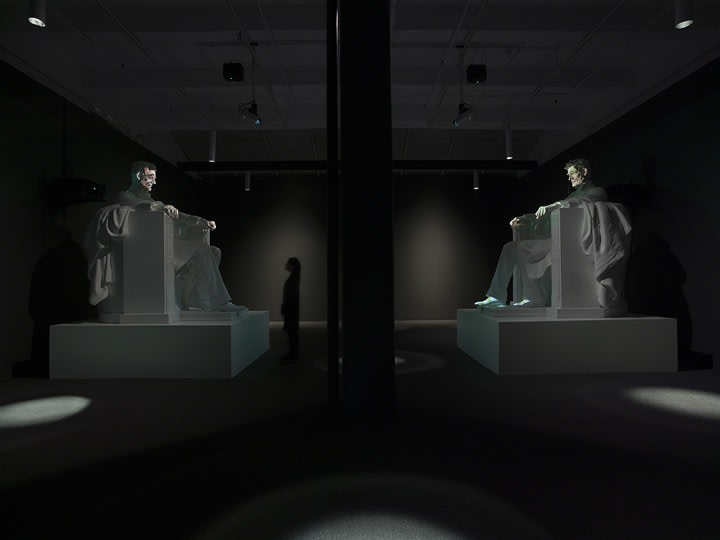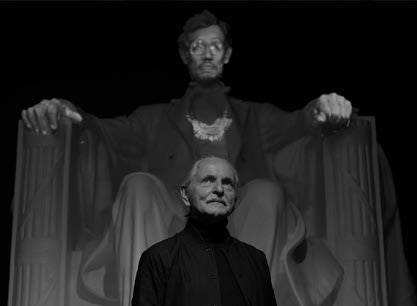Monument is a work of public art by Krzysztof Wodiczko (American, b. Poland 1943). The artist collaborated with twelve refugees who have been resettled in the United States; their filmed likenesses and spoken narratives are superimposed on the historic 1881 monument to Admiral David Glasgow Farragut, lauded in his day as a Union naval hero during the Civil War. Pertinent to this project is current scholarship documenting how the American Civil War drove millions – soldiers, civilians, stragglers, enslaved Africans, free people, Northerners and Southerners – from their homes to generate a nineteenth-century refugee crisis. Similarly, each filmed participant’s home country has suffered the devastation of civil war which prompted Wodiczko to choose the Farragut location for this project to compare how select individuals are lionized in wartime and others are overlooked. With footage of people from Africa, Central America, South Asia, and the Middle East, the bronze monument emerges as a surrogate for refugees whose diverse plights, harrowing journeys, grueling fortitude, and quest for democracy have recently brought them to this country. Refugees are adults and children who flee their home countries because of war, persecution, and violence and who cross borders into the promised safety of another country. Most of the speakers in this project have spent years in refugee camps.
The twenty-five minute video projection encourages viewers to consider how history is memorialized. In view of current controversies surrounding historic monuments, Wodiczko claims Farragut as a new monument by recontextualizing the statue whose almost one hundred and fifty years in Madison Square Park can make passersby overlook his presence.
Building on a practice that for more than fifty years has created platforms for and collaborated with marginalized voices, Wodiczko renders in high relief attention to global migration and the international refugee crisis in Monument. Farragut’s personage, a bygone symbol of American naval prowess, is updated and transferred to living individuals whose experiences are not regularly honored in public monuments. The project invites the public to acknowledge this country’s conflicted history of accepting and rejecting refugees, asylum seekers, and immigrants.
On view January 16 through May 10, 2020, and running from dusk to 9 PM Monday to Saturday, the installation will be complemented by a series of public programs, lectures, and events that expand upon the concepts explored within the work.
The artist and Madison Square Park Conservancy have partnered with Refugee Council USA, a coalition of humanitarian organizations including the International Rescue Committee, and Integrated Refugee and Immigrant Services. These organizations invited individuals to share their stories to form the foundation of Wodiczko’s footage. The participants’ refugee status is not compromised by their filmed presence. The artist is conscious that the reach of his work has long depended on the circumstances of others: Wodiczko has realized outdoor projects in cities and municipalities with war veterans, homeless people, families of victims of gun violence, women and children who have experienced domestic abuse, stateless individuals, and immigrants. His practice brings visibility to the invisible through immersive research, interviews, and placement in a public forum.
More information can be found online from the humanitarian organizations that collaborated on Monument: the International Rescue Committee, Refugee Council USA, and Integrated Refugee and Immigrant Services. rescue.org | rcusa.org | irisct.org


